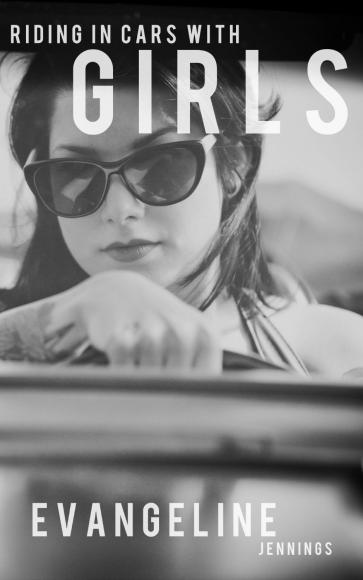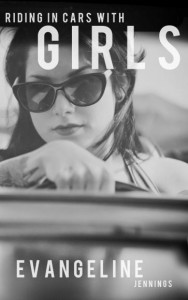Riding In Cars With Girls by Evangeline Jennings
– Reviewed by Elanor Clarke –
Riding in Cars with Girls is a collection that starts as it means to go on – strong. The opener – ‘Firebird’ – like the other titular cars in the series of stories, is more than just a reference to a car. Though the Firebird itself does take a reasonably central role in the story, Dorothy, the mysterious visitor to a small town with nothing to show for itself but a bar and a never-ending forest fire, is herself a firebird – drawn to the flames, inexplicably, and seeming to rise again in spirit within our narrator: a phoenix.
This careful choosing of cars to match characters (or, perhaps, characters to match cars) continues throughout. In ‘Escort’, for example, a girl fleeing from the mob is doing so in a stolen Ford Escort, and her profession echoes the title – the oldest profession.
As well as this clever use of word play, Evangeline Jennings has created believable microcosms in her stories; worlds drenched in noir that read as lush and altogether real. Though the scene-to-scene cuts and the dialogue seem suggestive of film, they work well on the page, leading to a fast-paced, fun read.
The first two stories focus on the States, and the America she creates is small towns with names like ‘Truth of Consequence’, no-name motels, Dairy Queens and roadside stores selling exactly what you wouldn’t expect. It’s an America where everyone drives everywhere, and their lives are in their cars – indeed, sometimes, their lives are taken there, too.
The third story takes place across Scandinavia, in a none-too-subtle and well-formulated nod to Nordic Noir. The storytelling takes on a slightly different tone, aided by the changing accents (and English-language issues) of new protagonists, but the carefully chosen landscapes remain.
‘Audi’ then moves us to the UK, to the tower blocks of South London and Helen Wheels, an aptly named heroine (if we can call her that) with a street name to match her ‘fast and furious’ personality. The unsubtle references to Atos and the benefits system, to disability and ableism, to the lengths some will go to to survive and thrive, will strike a chord with many. Helen and Wendy act as a pair of teenage Robin Hoods – taking cars from the rich to feed themselves – decidedly part of the poor. And, the comparison of Morden to Mordor certainly tickled me.
It’s in the USA that Jennings seems most at home, though, where she returns for the final two tales, with car chases across the country and hard-nosed anti-heroines taking the stage as towns flash by in the blink of a drug-fuelled eye.
Like the best of noir, the tales told here contain a heady mixture of sex, violence and death, told in a straightforward, succinct and elegant way. There are also tinges of humour along the way which help keep the whole thing from becoming too serious, including a none-too-subtle Arnold Schwarzenegger reference from a tough Homeland Security agent.
Hell features heavily in this collection, whether a fiery reference – straight to Hell – a t-shirt slogan or the infernal name of a night club (which, ironically, finds itself within an old church). Characters find themselves trapped in their own Hell, going towards it, or trying to escape in a under-layer giving depth to Jennings’ seemingly straightforward, if adventurous, storytelling.
If I had to point out one negative about Jennings’ work, it would be that, while she is generally on point with dialect, there is an odd mix of British and American spelling used within the stories, which could prove jarring for some – it did for me.
All in all, this is a well-written and engaging set of stories, with a group of crime noir femmes fatales who live up to their names, waging a path of destruction on the people who’ve wronged them. I hope to see more from Evangeline Jennings, who will undoubtedly go from strength to strength.






